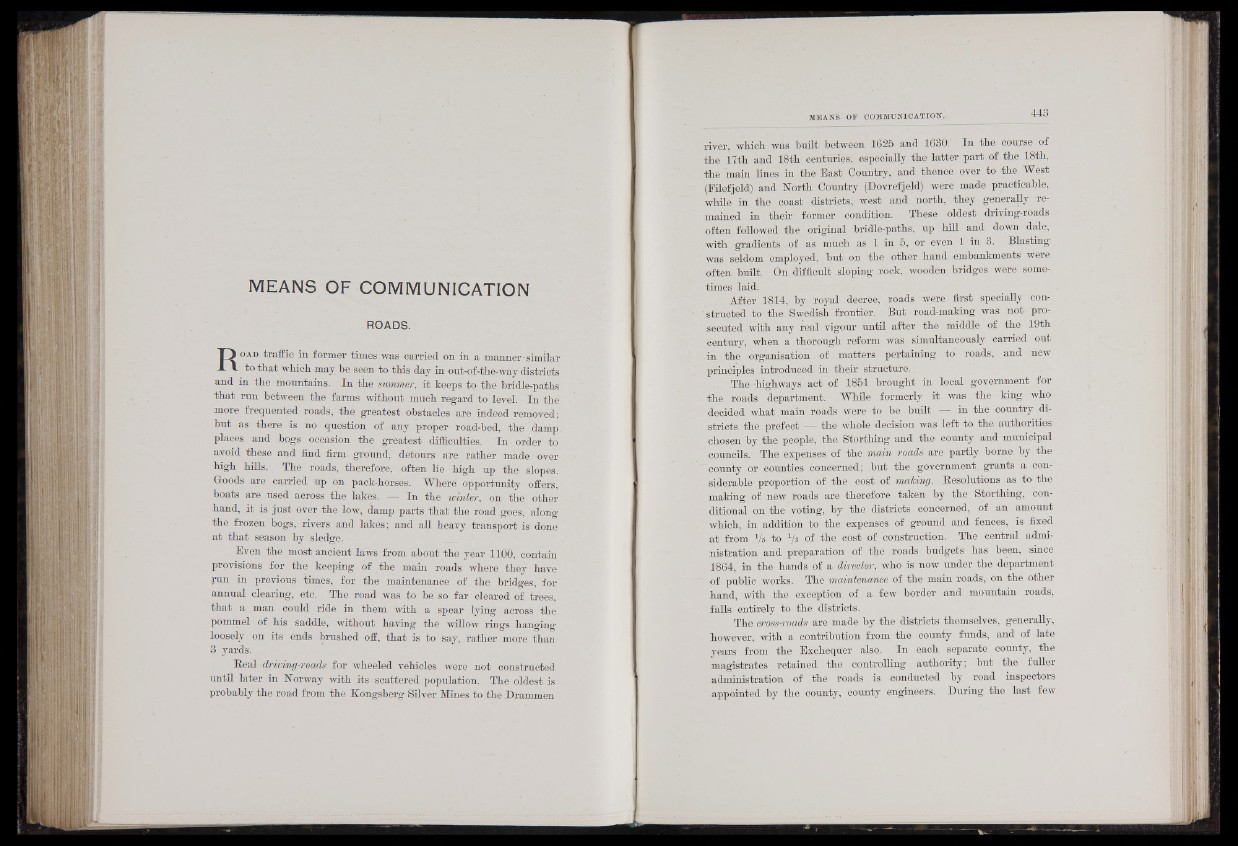
MEANS OF COMMUNICATION
ROADS.
Ro a d traffic in former times was carried on in a manner‘similar
to that which may; be seen to this day in out-of-the-way districts
and in the mountains. In the summer, it keeps to the bridle-paths
that run between the farms without much regard to level. In the
more frequented roads, the greatest obstacles are indeed removed;
but as there is no question of any proper road-bed, the damp,
places and b.ogs occasion the greatest difficulties. In order to
avoid these and find firm ground, detours are rather made over
high hills. The roads, therefore, often lie high up the slopes.
G-oods are carried up on pack-horses. Where opportunity offers,
boats are used across the lakes. B H ln the winter, on the other
hand, it is just over the low, damp parts that the road .goes, along
the frozen bogs, rivers and lakes; and all heavy transport is done
at that season by sledge.
Even the most ancient laws from about the year 1100, contain
provisions for the keeping of the main roads where they have
run in previous times, for the maintenance of the bridges,-for
annual clearing, etc. The road was to be so far cleared of trees,
that a man could ride in them with a spear lying across the
pommel of his saddle, without having t h e ‘willow rings hanging
loosely on its ends brushed off, that is to say, rather more than
3 yards.
Real driving-roads for wheeled vehicles were not constructed
until later in Norway with its scattered population. The oldest is
probably the road from the Eongsberg Silver Mines to the Drammen
river, which was built between 1625 and 1630. In the course of
the i7th and 18th centuries, especially the latter part of the 18th,
the main lines in the East Country, and thence over to the West
(Filefjeld) and North Country (Dovrefjeld) were made practicable,
while in th e ' coast districts, west and north, they generally remained
in their former condition. These oldest driving-roads
often followed the original bridle-paths, up hill, and down dale,
with gradients of as much as 1 in 5, or even 1 in 3. Blasting
was seldom employed, but on the other hand embankments were
often built. On difficult sloping rock, wooden bridges were sometimes
laid.
After 1814, by royal decree, roads were first specially constructed
to the Swedish frontier. But road-making was not prosecuted
with any real vigour until after the middle of the 19th
century, when a thorough reform was simultaneously carried out
in the organisation of matters pertaining to roads, and new
principles introduced in their structure.
The -highways act of 1851 brought in local government for
the roads department. While formerly it was the king who
decided what main roads were to be built - in the country districts
the prefect — the whole decision was left to the authorities
chosen by the people, the Storthing and the county and municipal
councils. The expenses of the main roads are partly borne by the
county or counties concerned; but the government grants a considerable
proportion of the cost of making. Resolutions as to the
making of new roads are therefore taken by the Storthing, conditional
on the voting, by the districts concerned, of an amount
which, in addition to the expenses of ground and fences,. is fixed
at from Vs to Vs of the cost of construction. The central administration
and preparation of the , roads budgets has been, since
1864, in the hands of a director, who is now under the department
of public works. The maintenance of the main roads, on the other
hand, with the exception of a few border and mountain roads,
falls entirely to the districts.
The cross-roads are made by the districts themselves, generally,
however, with a contribution from the county funds, and of late
years from the Exchequer alsQ. In each separate county, the
magistrates retained the controlling authority; but the fuller
administration of the roads is conducted by road inspectors
appointed by the county, county engineers. During the last few